Second Life of Political Leaders: A Case Study of Adolf Hitler

Arleta Dulkowska
Willy Brandt Center for German and European Studies-WBZ
Arleta Dulkowska was a DAAD/AICGS Research Fellow during October-November 2014 and is a PhD student at the Willy Brandt Center for German and European Studies-WBZ (funded by the German Academic Exchange Service and the University of Wroclaw). In her dissertation, she describes the usage of Hitler’s image in American pop culture. Ms. Dulkowska holds an MA degree in Law Studies from the University of Silesia, Katowice; an MA degree in Informatics from the University of Silesia, Sosnowiec; an MA degree in European Diplomacy from the University of Wroclaw/WBZ, Wroclaw; and a BA degree in European Studies from The General Jerzy Zietek Silesian School of Management in Katowice. She also graduated from a one year program, the Academy of Young Diplomats (the European Academy of Diplomacy). During her DAAD/AICGS fellowship, she will present the contemporary approach to Hitler’s image in film, music, comics, internet, and fashion, and analyze the origins of this phenomenon and differences between two approaches: contemporary and traditional. She will also analyze how intellectual property rights are related to this phenomenon.
The Role of Adolf Hitler’s Image in American Popular Culture
In recent times, the term “second life” relates to a web game in which people create characters of themselves. However, they often give themselves a new virtual identity, thereby creating a “second life.” In the game, an office worker can become a treasure hunter, or an IT specialist can be a robot. Indeed, the game claims to be the leading 3D virtual world where one can be whoever one would like. This phenomenon is analogous to the contemporary presentation of political leaders. The possibility of creating a virtual character is one of the signs of the twenty-first century, because a virtual world offers so many opportunities to both redefine and distort reality. Both the development of information technology, as well as popular culture, reinforces and promotes this phenomenon.
The use of images of political figures in popular culture was seen mainly in the first half of the twentieth century, but it has spread rapidly in recent years. Political figures are viewed in almost all aspects of popular culture including pop music, fashion, comics, and film. So-called “memes” associated with them have become a permanent part of many websites. In this way, they are omnipresent in the popular culture of our time, going hand in hand with an increase of their popularity and tangibility in everyday life. One of the most surprising aspects of this trend is the giving of new identities to the figures, a so-called “second life.” As a result, correctness and historical paradigms are allowed to fade into the background.
Nowadays, this process involves a number of different categories, which can be attributed to the broader range of figures. One of these categories is political leaders, which is heterogeneous and includes characters not only from around the world, but also who have made contributions to peace, destruction, and demoralization. Thus, among the leaders are Pope John Paul II, Joseph Stalin, Che Guevara, and Adolf Hitler. This essay will discuss a few aspects of Adolf Hitler’s “second life” in modern popular culture.
Adolf Hitler: The Man behind the Character
Adolf Hitler is a figure who evokes extreme emotions: fear, mockery, hatred, indifference. Most people cannot ignore his crimes against humanity as the leader of the Third Reich, and his image is probably one of the most recognizable in the world. In his rise to power and during the Third Reich, Hitler gained respect through carefully organized speeches and rallies—met with applause—and was like an actor on stage. During his speeches, he changed facial expressions, spoke with increasing volume, and used sound or visual effects, including lights, banners, and flags. This created a directed scene of planned presentation, which he used to promote the cult of himself. His power stemmed from an extraordinary force of demonic influence on people. So how did it happen that such a person responsible for the atrocities of the Third Reich has become a pop culture icon, a “hero” of memes, comic books, and other creations of popular culture?
After World War II, a large part of German society had hoped that, in the future, the world would forget about the Third Reich and its chancellor. But today Adolf Hitler is remembered differently than his conquerors could have imagined. His image has been absorbed by popular culture, because it “consumes” everything, even totalitarianism.
Adolf Hitler and American Popular Culture
In trying to define the concept of popular culture, the term of “culture” should be explained. Today, there are so many definitions of both phenomena, which are related to the prospects of selected scientific fields. The descriptions of culture often specify, as an element, the concept of “migrating symbols/icons.” Signs, emblems, and people do not migrate without external factors; they are captured or in some way absorbed by rival tribes, groups, or nations. The best example of this phenomenon is the swastika, a symbol which is universally recognized as Germanic, and associated primarily with Nazism and the person of Adolf Hitler.
Although it began during World War II, the phenomenon of using Hitler’s image in popular culture has grown in recent years. Many American museums have exhibitions devoted to Hitler or Nazi Germany. The National Museum of American Jewish Military History offers insight into understanding the genesis of using Hitler’s image in pop culture. The cartoon from the 1939 issue of The Jewish Veteran shows the boycott’s success in putting pressure on Nazi Germany, probably one of the first cartoons showing Hitler in a ridiculous way and poster related to boycott of German industry.
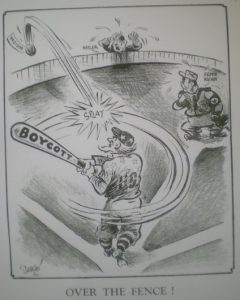

The National Museum of American History devotes one exhibition to the beginning of this phenomena. So-called “Hollywood Goes to War” contains explanation as to why the entertainment industry produced dozens of patriotism-building, morale-boosting films in support of the war effort: movies, which were produced in collaboration with the U.S. Office of War Information, pitted heroic Americans against villainous Nazis. This approach was different than in Europe, where Hitler and Nazi Germany were generally presented as the embodiment of evil. Americans decided to portray Hitler in such a bizarre way in order to change society’s thinking about the war and instill confidence in victory, because surely it was easier to win against a funny Hitler than against the demon. This was the beginning of using and presenting Hitler in a different, more funny than serious, way.
Nowadays, Hitler’s figure is palpable in almost every “strand” of popular culture, from pop music to fashion to advertising. Hitler is thus ubiquitous and omnipresent in the culture of our time.
Hitler in Popular Music
Music is one of the most easily recognized influencers of pop culture. Because it uses a universal code, most sounds are understood throughout the world. Often, the text is ignored in pop hits and catchy melodies, or the artist’s looks, or gestures come to the fore. Moreover, it fits in one of the elementary functions of mass culture: entertainment. While twentieth century music has grown to include rock’n’roll, pop, hip-hop, and rap, the imagery of Hitler has remained pervasive. Gene Wilder’s song: “Springtime for Hitler,” describes the art of killing by the Nazis with the chorus:
Springtime for Hitler and Germany
Deutschland is happy and gay
Springtime for Hitler and Germany
Winter for Poland and France
On the other hand, Anthony and the Johnsons released a song called “Hitler in My Heart,” where the name of the leader is used as a metaphor for evil:
As I search for a piece of kindness
And I find Hitler in my heart and he is whispering
“As sure as love will spring from the Well of Blood in Vain
Oh Jew! The Well of Blood in Vain!”
Similarly, in the song by Faith No More “Crack Hitler”:
…My usage of the drug…
it modified my personality
to the extent that I was
highly irritable
I was like a crack Hitler
Hitler today is not only a hero featured in the songs, but has become a star of popular music—he sings, raps, and dances—in dozens of videos found on the most popular video-sharing website, youtube.com. On one of the videos Hitler raps the words “Adolf H, Deutschland, Deutsch” to the beat of a hip-hop remix of the well-known 50cent song “In da club.” The song “Hip Hop Adolf Hitler” has been listened to over 60,000 times; its youtube.com page bears the following picture:

Similarly, in “Der Diktator Song,” which was created as a “duet” with Goebbels, excerpts from his speeches are set to the rhythm of the popular tune “Pinky und der Brain.” The song also shows a video, visited nearly 200,000 times,of both Hitler and Goebbels during their speeches:
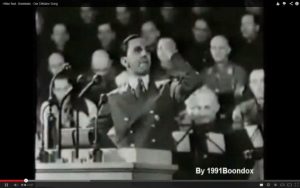

Hitler is not just a rap or pop star, but also metal. Another popular song is “Hitler Song One- Heil” and recordings with Adolf Hitler also exist in mainstream techno, for instance, the “Techno Hitler” song with a picture of Hitler with headphones, or “Adolf Hitler SONG LOL” showing Hitler as a DJ, or “Adolf Hitler – Mother Führer Gentleman.”

It is impossible to describe and demonstrate all the different kinds of music where the image or name of leader of the Third Reich have been used. Even the popular Korean pop (K-pop) song “Gangnam Style” has been parodied with the video “Downfall-Hitler Gangnam Style Parody” with nearly 4 million viewers.
Adolf Hitler is clearly present in music. There is also continued interest in Hitler in the areas of music and the use of his image by performers, as well as by video editors, shows the desire to cause sensation in their work, but rarely tell the story of the past.
Hitler in Comics
The earliest comics appeared in the United States with such heroes as Superman, Batman, or Captain America. Today, Hitler is also present in this area of popular culture. In the volume entitle “Exile” of its “Weird Fantasy” series, American comics publisher EC Comics tells the story of Earth becoming a criminal camp where people with bad genes are sent, and describes its last prisoner: Adolf Hitler. Moreover, DC Comics used characters of German leaders and released the story of how Hitler was abducted by aliens before he could commit suicide, and his false body had been found members of the SS. As punishment for his evil deeds, Hitler is imprisoned on a spaceship and has to travel until his death, further punished by constantly listening to recordings of his speeches. However, in Erik Larsen’s comic “The Savage Dragon,” which was published by Picture Comics, it turns out that Hitler died after fighting with fictional superhero Hellboy in Romania in 1952. He had the powers of psychokinesis and telepathy through which he became the leader of a criminal organization called “vicious circle.”
The graphic novel by Alan Moore and Eddie Campbell “From Hell” tells the story of Jack the Ripper. In one scene, we see Hitler’s mother Klara, who has a vision of the Holocaust.
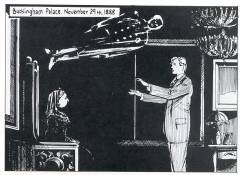
Another comic book about the fate of the Führer was “The New Adventures of Hitler,” created by Grant Morrison and Steve Yeowell. They described his life in Liverpool, England, where he lived with his “insane” cousin and was looking for the Holy Grail.
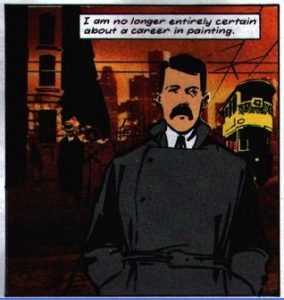
Better-known comics that depict the leader of the Third Reich are the adventures of Captain America, where he is the opposite of this superhero. In these examples, Hitler is a dark character. Comic creators are using him as a personification of evil, which stands in opposition to superheroes.
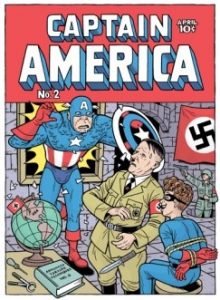
Fashion and Hitler
With the process of globalization in the twentieth century, fashion took on more images from popular culture. T-shirts and other items feature portraits of rock bands, actors—and Adolf Hitler. One example from the website micetrap.net includes t-shirts with the “route” of Adolf Hitler in the style of a band’s touring schedule.
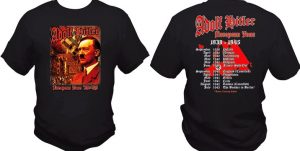
Trying to buy something controversial online related to Hitler is easy, and items range from clothes to bottle openers and key chains to phone covers.


Hitler in the Press
The twenty-first century is an era of a new kind of journalism. The twenty-four hour news cycle is focused on sensational, controversial topics and celebrities. Adolf Hitler is often a topic. Articles about the leader of the Third Reich vary from serious historical topics related to World War II to personal curiosities, such as the watch that Hitler gave to Eva Braun for Valentine’s Day.
Hitler on Television and Film
The concept of television also refers to the auditions and television programs that take on topics related to Adolf Hitler. For example, one segment of the BBC series “Secrets of World War II” (“Adolf Hitler’s Last Days”) described the last moments of the life of the former leader of the Third Reich. A two-part series called “Hitler: The Rise of Evil” from 2003 tells the story of Hitler’s youth and his rise to power. Hitler also appears in the episode “The Passion of the Jew” in the television series “South Park,” where he is depicted as a fictional character in Hell singing Christmas carols.

The image of Adolf Hitler was also used in other animated series, including “The Simpsons,” “Family Guy,” “Futurama,” or “Tom and Jerry.”



Adolf Hitler is often used in television productions. The former leader is seen not only in serials or cartoons, but also appears on the big screen. The first film to use a satirical picture of the Führer was directed by Charlie Chaplin in 1940: “The Great Dictator.” This film presents the story of authoritarian ruler Hynkel and a Jewish barber, who look alike. Hynkel has a dream of conquering the land Austerlich, but first must plan the strategy of defeating Napoleon. However, he falls in his own trap. At the same time, the barber escapes from camp, which is shown as Hynkel gives a speech of peace. “The Great Dictator” is an allegory of Hitler’s rule and carries a message of opposition to the dictatorship.
Hitler on the Internet
Today, there are many websites related to Hitler. In addition to those sites that describe the facts of Hitler’s life, such as e-encyclopedia or Britannica, there are many websites addressing more speculative subjects, such as the “real” Hitler, his sexual orientation, his religion, and his files in the FBI’s archive. However, one can also find a huge amount of humorous websites, Führer “memes” (Emo Hitler, baby Hitler, Pikachu Hitler, dancing Hitler, or Hitler with iPhone).

Moreover, many blogs are dedicated to Hitler and associated with the history of his life. There are also blogs written on “behalf” of the Führer such as dailyhitler.blogspot.com, where information related to Hitler’s life is portrayed; for example, that there is a new toy with his appearance or sending Mother’s Day greetings with the photo of Klara Hitler.
Hitler is also popular in the world of social media. There are Hitler accounts on both Facebook and Twitter, where humorous drawings and texts are posted.

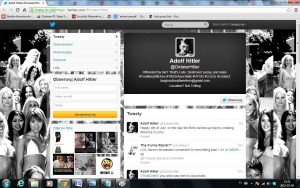
Conclusion
Adolf Hitler is one of the most famous figures in history. Menacing in his day, in the modern world Hitler has become an icon of popular culture through a complex and complicated phenomenon of film, television, comics, toys, the internet, and so on. Hitler enters our homes in the form of bottle openers, t-shirts, and internet memes. In the twenty-first century, Hitler has become an icon of popular culture, showing mass insanity, volatility of customs, and extending the boundaries of culture. Today, Hitler can “do” almost everything, and the boundaries depend only on the concepts and ideas of the creators. There is the possibility of putting his face in the body of Pikachu, creating a clothing line, or leading an army against him in a computer game. The picture below perfectly reflects the conversion of Hitler, his reincarnation. On the left side there is a former Hitler, on the right is a modern man, who lives in the twenty-first century.

In this way, Hitler has been given a new identity. He is not depicted only as a monster killing millions of people in gas chambers, but is also shown as an “emo child,” a funny Pokémon, or a comic book hero. Above all, he is an icon of popular culture.
Arleta Dulkowska was a DAAD/AGI Research Fellow during October-November 2014 and is a PhD student at the Willy Brandt Center for German and European Studies-WBZ.








